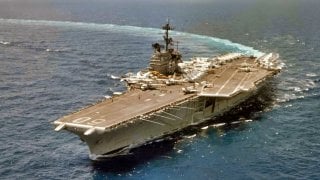USS Saratoga: The Unforgettable U.S. Navy Aircraft Carrier
The USS Saratoga (CV-60) was a Forrestal-class aircraft carrier commissioned in 1956, serving as a cornerstone of U.S. naval power during the Cold War. Measuring over 1,000 feet in length and capable of carrying up to 90 aircraft, she was instrumental in projecting American influence, primarily in the Mediterranean.
Summary and Key Points: The USS Saratoga (CV-60) was a Forrestal-class aircraft carrier commissioned in 1956, serving as a cornerstone of U.S. naval power during the Cold War.
-Measuring over 1,000 feet in length and capable of carrying up to 90 aircraft, she was instrumental in projecting American influence, primarily in the Mediterranean.
-The Saratoga participated in key historical events, including hosting Presidents Eisenhower and Nixon, and earned a battle star for her service in the Vietnam War. Notable incidents during her nearly four decades of service include a collision with a German freighter and a machinery space fire.
-Decommissioned in 1994, the Saratoga was scrapped by 2019, leaving behind a legacy of dedication and strength.
USS Saratoga: The Cold War Aircraft Carrier That Made History
After a two-front victory in the Second World War, the United States emerged as a geopolitical power with global influence.
As one pole in a new bipolar world order, the U.S. in the middle of the 20th century became a world leader in every way – social, economic, and military. And few things spoke to America’s global influence, or its ability to project power internationally, like the U.S. fleet of aircraft carriers.
One of the U.S.’ most important Cold War-era aircraft carriers was the USS Saratoga (CV-60), a Forrestal-class vessel named for the Battle of Saratoga in the American Revolutionary War.
The Saratoga was commissioned in 1956, as the Cold War was beginning to take shape. She would spend the majority of her career in the Mediterranean, quietly applying U.S. pressure and influence on the European continent. The Saratoga would also participate in the Vietnam War – where she received one battle star – and in Operation Desert Storm. She was decommissioned in 1994 after almost four decades of service.
Building the Aircraft Carrier USS Saratoga
The contract for what would become the USS Saratoga was awarded to the New York Naval Shipyard in Brooklyn, New York, in 1952. The boat was to be the second of four Forrestal-class carriers. The boat was laid down on Dec. 16, 1952, and launched on Oct. 8, 1955.
The nuclear-powered Saratoga was the first U.S. Navy carrier to use high-pressure 1,200 psi boilers, which Babcock & Wilcox supplied to power the ship’s four Westinghouse-geared turbines.
The vessel’s power plant was capable of generating 280,000 shaft horsepower – good for a 35-knot top speed. The Saratoga measured 1,063 feet long, with a 252-foot beam and a 37-foot draft. The hulking vessel displaced over 81,000 tons when fully loaded.
The Saratoga was outfitted with a suite of sensors and processing systems, including the AN/SPS-48 3D air search radar, the AN/SPS-48 2D air search radar, the AN/SPS-10 surface search radar, and the Mark 36 SRBOC electronic warfare and decoy system. The carrier was also armed with eight 5-inch/54 caliber Mark 42 guns and the NATO Sea Sparrow Phalanx Close-In Weapons System.
The Saratoga was one of just 10 aircraft carriers configured to operate the Regulus, a turbojet-powered subsonic guided missile. The Saratoga became one of six carriers to actually launch the Regulus when she performed two test launches. Most importantly, the Saratoga could carry up to 90 or so aircraft, allowing the U.S. to project air power anywhere on the high seas.
On June 6, 1957, the Saratoga hosted a distinguished visitor: President Dwight D. Eisenhower, who, along with members of his Cabinet, observed as the carrier conducted air, antisubmarine, guided missile, and bombing operations. To cap off the president’s visit, two F8U Crusaders landed aboard the Saratoga, having completed a nonstop coast-to-coast flight in three hours and twenty-eight minutes from the deck of the USS Bon Homme Richard.
At Sea With the Saratoga
The Saratoga began the 1960s with an unfortunate incident, colliding with the German freight Bernd Leonhardt off the coast of North Carolina. The freighter’s bridge and superstructure were damaged after coming into contact with the Saratoga’s flight deck.
The collision was investigated, and while the results of the investigation were never published, the Navy did pay for the $2.5 million-worth of repairs, implying some level of fault. Just a few months later, in January 1961, a significant fire occurred in Saratoga’s number two machinery space. Seven sailors were killed. A ruptured fuel oil line is believed to have caused the fire.
In 1969, the Saratoga again hosted a sitting U.S. president when Richard Nixon visited to observe firepower demonstrations.
In 1972, the Saratoga was deployed to the Western Pacific to participate in the Vietnam War. Jets operating from the Saratoga conducted hundreds of sorties against North Vietnamese targets. This engagement was the most significant action that the Saratoga would ever see. The Saratoga wouldn’t experience direct conflict again until Operation Desert Storm, where her role was relatively limited.
The long-serving Saratoga would not be decommissioned until 1994. The vessel was scrapped, a process that lasted until 2019.
About the Author: Harrison Kass, Defense Expert
Harrison Kass is a defense and national security writer with over 1,000 total pieces on issues involving global affairs. An attorney, pilot, guitarist, and minor pro hockey player, Harrison joined the US Air Force as a Pilot Trainee but was medically discharged. Harrison holds a BA from Lake Forest College, a JD from the University of Oregon, and an MA from New York University. Harrison listens to Dokken.
Image Credit: Creative Commons.


